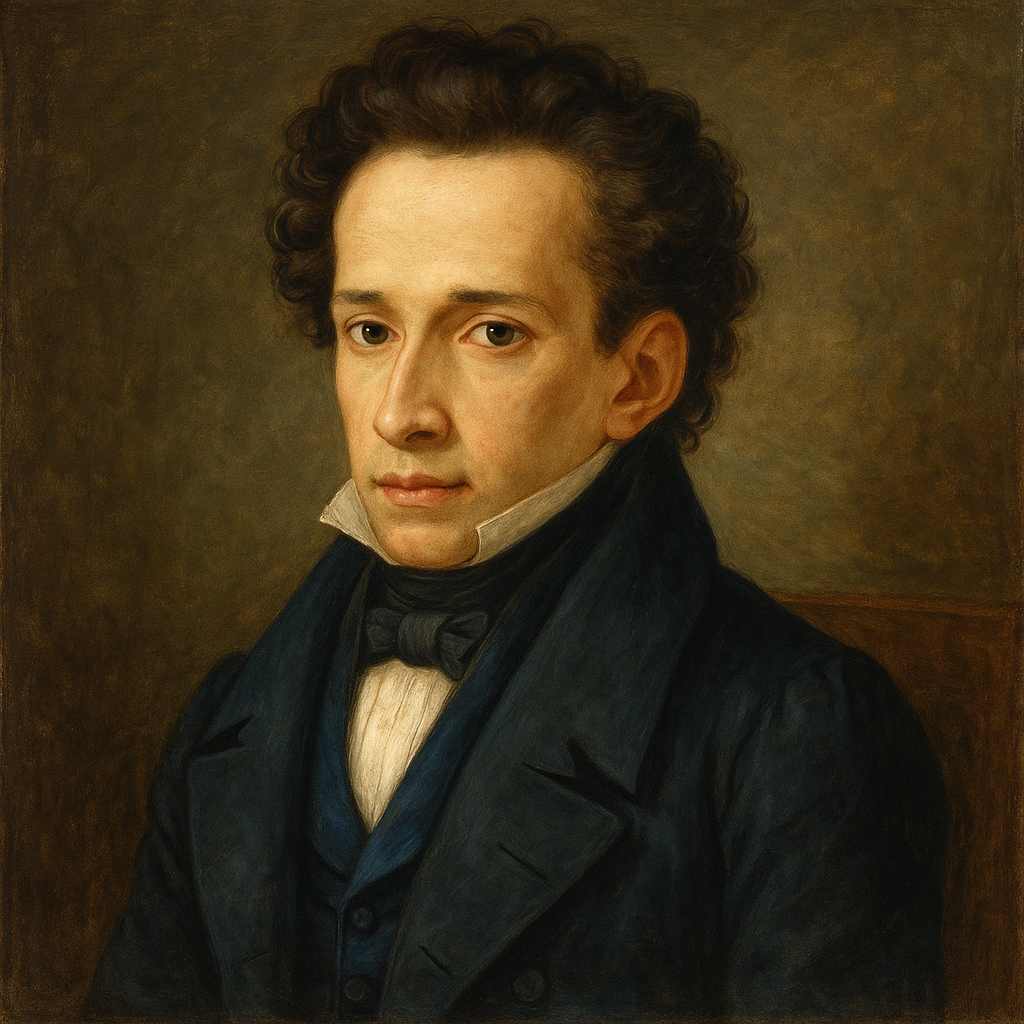The Infinite (Italian)
Giacomo Leopardi
1798 to 1837

Sempre caro mi fu quest'ermo colle,
e questa siepe, che da tanta parte
dell'ultimo orizzonte il guardo esclude.
Ma sedendo e mirando, interminati
spazi di là da quella, e sovrumani
silenzi, e profondissima quiete
io nel pensier mi fingo, ove per poco
il cor non si spaura. E come il vento
odo stormir tra queste piante, io quello
infinito silenzio a questa voce
vo comparando: e mi sovvien l'eterno,
e le morte stagioni, e la presente
e viva, e il suon di lei. Così tra questa
immensità s’annega il pensier mio:
e il naufragar m'è dolce in questo mare.
Giacomo Leopardi's The Infinite
Giacomo Leopardi’s The Infinite (L'infinito) is one of the most celebrated Italian Romantic poems, first published in 1819. This meditative piece reflects Leopardi's philosophical preoccupation with nature, solitude, and the concept of the infinite. Written in Italian in the form of a single, unbroken stanza, the poem explores the dialectic between the finite and the infinite, drawing the reader into a contemplation of eternity and human insignificance. Through the juxtaposition of sensory experience and abstract thought, Leopardi immerses the reader in a unique aesthetic and philosophical journey.
Structural and Stylistic Elements
Leopardi employs a flowing, rhythmic structure without the interruptions of stanzas, reinforcing a sense of continuity and boundlessness that mirrors the thematic exploration of infinity. The poem’s meter and enjambment propel the reader forward, reflecting the limitless progression of thought and the seamless blending of perceptions. Leopardi’s choice of Italian phrasing and sound mirrors natural rhythm and flow, particularly in the phonetic echoes and elongated vowel sounds that produce a tranquil, meditative tone.
Analysis of Key Themes and Imagery
-
The Symbolism of the Hill and Hedge: The poem begins with Leopardi reflecting on the "lone hill" (ermo colle) and "hedge" (siepe) before him. These natural features initially seem confining, as the hedge blocks the speaker's view of the distant horizon. However, this limitation becomes a paradoxical gateway to contemplation. By obstructing the speaker’s vision, the hedge stimulates an imaginative leap, propelling him beyond physical reality into the realm of the infinite. This use of natural elements as conduits for the metaphysical is a quintessential Romantic device, transforming the ordinary into a source of sublime experience.
-
Imagination and Infinity: Leopardi’s imagination transports him to “endless spaces” (interminati spazi) and “more-than-human silences” (sovrumani silenzi), where he encounters a "deep tranquility" (profondissima quiete). The contrast between the restricted view and the vastness of what he envisions beyond the hedge introduces a tension between the finite and the infinite. These “endless spaces” serve as an embodiment of metaphysical infinity, underscoring the Romantic fascination with the sublime—the mixture of awe and terror in the face of nature’s immensity, which here verges on spiritual or existential revelation.
-
Sound, Silence, and Memory: Leopardi introduces the element of sound with the line “I hear the wind rustle through these trees” (odo stormir tra queste piante), contrasting this earthly, temporal sound with the “boundless stillness” (infinito silenzio) he imagines. The interplay between sensory experiences—the sound of the wind—and the silence of the infinite deepens the poem’s exploration of perception versus reality. This comparison encapsulates the human tendency to seek the eternal within the fleeting, the cosmic within the mundane.
-
Temporal Reflections: The speaker's thoughts segue from the contemplation of the eternal to reflections on time, as he recalls “the dead seasons” (le morte stagioni), the "present, living one" (e viva), and the sounds associated with them. This awareness of temporality within the vastness of infinity reinforces the poem's Romantic longing for transcendence. Leopardi simultaneously acknowledges the ephemeral nature of life and the immutable passage of time, suggesting a cyclical view of existence that emphasizes the fluidity between past, present, and future.
-
The Sweetness of Dissolution: The poem concludes with one of its most famous lines: “and to founder in this sea is sweet to me” (e il naufragar m’è dolce in questo mare). Here, Leopardi employs the metaphor of drowning, portraying the speaker’s immersion in the infinite as both a form of escape and a surrender to something greater. This line encapsulates the Romantic ideal of losing oneself within nature’s immensity, where selfhood dissolves into a sense of cosmic unity. It also hints at the paradox of pleasure in surrender, as the speaker finds solace in the very idea of being overwhelmed by infinity.
Conclusion
Leopardi’s The Infinite combines personal reflection with universal themes, rendering it both intimate and cosmic. The poem embodies a quintessential Romantic tension between limitation and boundlessness, allowing Leopardi to transcend the constraints of physical reality through the power of imagination. His introspection not only leads him into an understanding of eternity but also reflects a philosophical acceptance of human limitations. In merging the finite with the infinite, Leopardi’s poem offers a meditation on existence that is at once profound and bittersweet, capturing the elusive, ineffable experience of the sublime.
This text was generated by AI and is for reference only. Learn more
Want to join the discussion? Reopen or create a unique username to comment. No personal details required!



Comments
No comments yet. Be the first to comment!